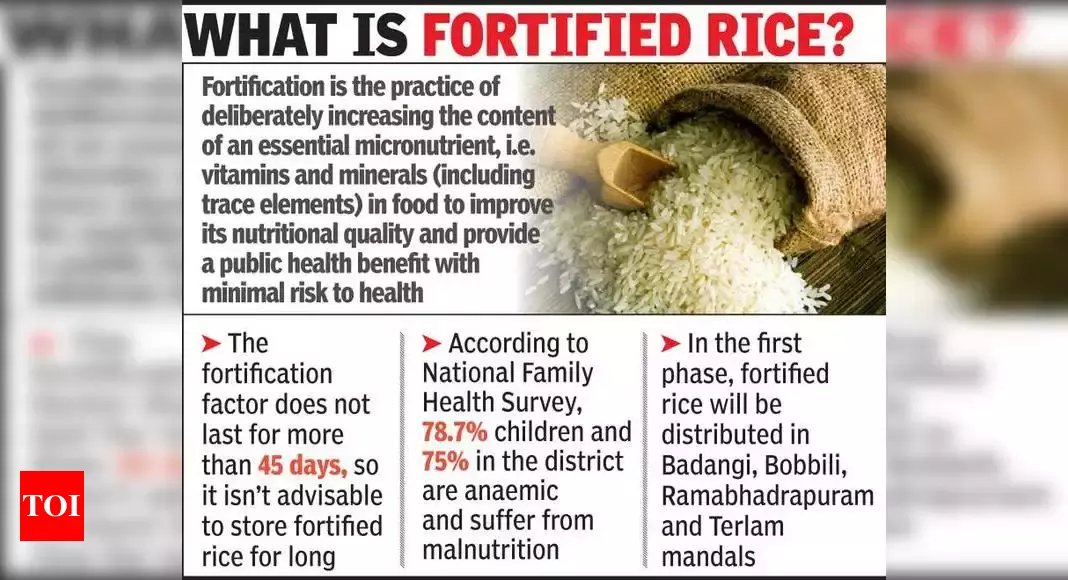Published on: October 10, 2021

RICE FORTIFICATION & INDIA
RICE FORTIFICATION & INDIA

What :
- The Food Safety and Standards Authority of India (FSSAI) defines fortification as “deliberately increasing the content of essential micronutrients in a food so as to improve the nutritional quality of food and to provide public health benefit with minimal risk to health”.
- In other words, rice fortification is a process of adding micronutrients to regular rice.
How is India conducting Fortification :
- For rice fortification in India, ‘extrusion’ is considered to be the best technology.
- In extrusion technology
- Dry rice flour is mixed with a premix of micronutrients
- Water is added to this mixture
- This mixture then goes into a twin-screw extruder with heating zones, which produces kernels similar in shape and size to rice.
- These kernels are dried, cooled and packaged for use which have a shelf life of at least 12 months.
Ministry of Consumer Affairs, Food and Public Distribution guidelines on Kernel
- The shape and size of the fortified rice kernel should “resemble the normal milled rice as closely as possible”
- The length and breadth of the grain should be 5 mm and 2.2 mm respectively.
Why is rice fortification needed:
- High levels of malnutrition among women and children
- According to the Food Ministry, every second woman in the country is anaemic and every third child is stunted. India ranks 94 out of 107 countries on the Global Hunger Index (GHI), which puts it in the ‘serious hunger’ category.
- Fortification of food is considered to be one of the most suitable methods to combat malnutrition.
- Rice is one of India’s staple foods, consumed by about two-thirds of the population. Per capita rice consumption in India is 6.8 kg per month.
- Therefore, fortifying rice with micronutrients is an option to supplement the diet of the poor.
India’s capacity for fortification
- According to the Ministry, nearly 2,690 rice mills have installed blending units for production of fortified rice, and the current blending capacity stands at 13.67 lakh tonnes in 14 key states. FRK production has gone up from 7,250 tonnes to 60,000 tonnes within 2 years.
- Existing rice mills need to be upgraded to fortification facilities. The cost of the upgrade varies from mill to mill depending on the volume of fortified rice produced. According to the Ministry, an investment of around Rs15-20 lakh would be required to upgrade a rice mill of operating capacity 4-5 tonnes/hour.
How can a beneficiary identify that she is getting fortified rice and not regular rice: Fortified rice will be packed in jute bags with the logo (‘+F’) and the line “Fortified with Iron, Folic Acid, and Vitamin B12” mandatorily printed on the pack.
Has the government distributed fortified rice earlier:
- In 2019-20, the Ministry launched a centrally sponsored pilot scheme, ‘Fortification of Rice and its Distribution under PDS’, for three years with a total budget outlay of Rs 174.64 crore. The pilot scheme focuses on 15 districts in 15 states — Andhra Pradesh, Kerala, Karnataka, Maharashtra, Odisha, Gujarat, Uttar Pradesh, Assam, Tamil Nadu, Telangana, Punjab, Chhattisgarh, Jharkhand, Uttarakhand, and Madhya Pradesh.
- According to the Ministry, six states, including Maharashtra and Gujarat, have started distributing fortified rice as part of the pilot scheme, with approximately 2.03 lakh tonnes distributed until June 2021. Four more states are expected to start by September.
Has any other country tried this: According to the Ministry, seven countries have mandated rice fortification — the United States, Panama, Costa Rica, Nicaragua, Papua New Guinea, Philippines, and the Solomon Islands.

